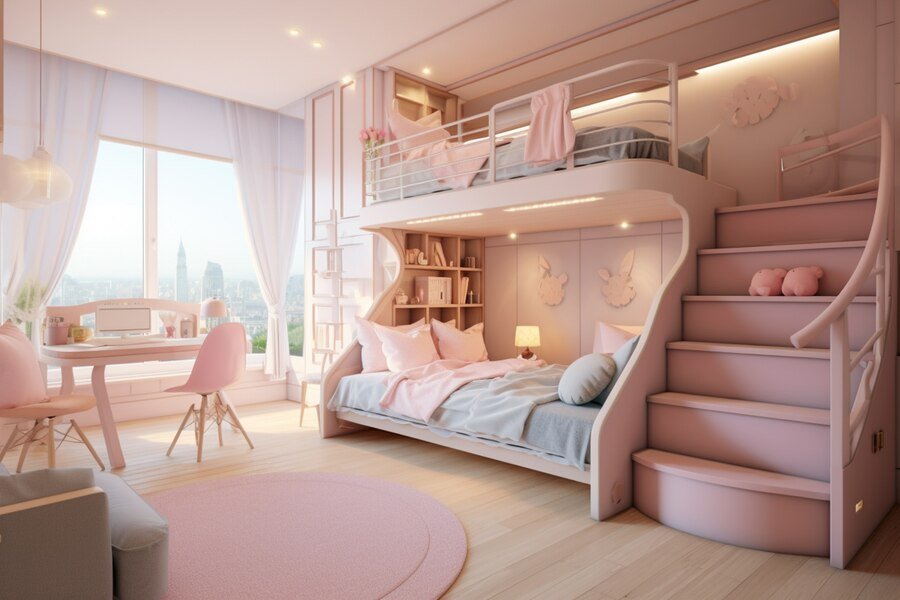Creating the perfect space for children is crucial, and selecting the right furntiure for childeren room plays a vital role in their comfort, safety, and development. From baby cribs to study desks, each piece of furniture has a significant impact on a child’s daily life and growth. Parents often face the challenge of finding functional, durable, and age-appropriate furnishings that can keep up with their little ones’ changing needs.
This comprehensive guide aims to help parents navigate the world of children’s room furniture. It covers essential items like convertible cribs, toddler beds, storage solutions, bunk beds, and study areas. The article also explores comfortable seating options to create cozy reading nooks or play spaces. By the end, readers will have a clear understanding of the best furniture choices to create a safe, functional, and inviting environment for their children to sleep, play, and learn.
Convertible Cribs and Toddler Beds
Convertible Crib Features
Convertible cribs are a smart investment for parents, designed to grow with children from infancy to toddlerhood. These versatile pieces of furniture can transform from a crib to a toddler bed, and some models even convert into full-size beds. The Graco Hadley Five-in-One Convertible Crib, for example, offers additional storage with drawers and shelves, making it a practical choice for nurseries. For a modern touch, the Sloan Acrylic Convertible Crib from Pottery Barn Kids features clear acrylic slats, allowing for better visibility of the child.
Convertible Crib Safety
Safety is paramount when choosing a crib. Parents should follow these important guidelines:
- Ensure the distance between slats is no more than 2-3/8 inches.
- The mattress should fit firmly without gaps.
- Corner posts should be flush with the headboard or over 16 inches tall.
- Always follow manufacturer’s assembly instructions.
- Conduct regular safety checks, tightening screws and replacing broken hardware promptly.
Convertible Crib to Toddler Bed Transition
The transition from crib to toddler bed typically occurs around 2 to 3 years of age. However, it’s essential to consider the child’s readiness rather than rushing the process. Signs that a child may be ready include asking for a “big kid” bed or outgrowing the crib’s size. To make the transition smoother, involve the child in the process by allowing them to make simple choices about their new sleeping arrangement.
Kids Dressers and Storage Solutions
Kids Dresser Styles
When selecting dressers for children’s rooms, parents have various options to choose from. Convertible dressers are popular choices as they can adapt to a child’s changing needs. Some models, like the Graco Hadley Five-in-One Convertible Crib, offer additional storage with drawers and shelves. For a modern touch, clear acrylic slats in dressers allow better visibility of the child’s belongings.
Kids Dresser Safety Features
Safety is paramount when it comes to children’s furniture. Parents should look for dressers with anti-tip hardware for items over 27 inches tall. This feature allows the furniture to be securely bolted to the wall, preventing tipping accidents. Drawer stops are another crucial safety feature, using strong metal guides to prevent drawers from falling out. Rounded corners or softened edges on youth furniture can minimize injuries from accidental bumps.
Kids Dresser Organization Tips
Organizing a child’s dresser can be challenging, but with the right approach, it becomes manageable. Start by sorting clothes into distinct piles, such as T-shirts, long-sleeved shirts, and pants. Consider organizing drawers by season or by how the child gets dressed in the morning. Labeling drawers with pictures or words can help children maintain the organization system. For easier folding, parents can demonstrate the process or use a flip-folding board. Stacking clothes vertically in drawers allows children to see more options and helps with color sorting.
Bunk Beds and Loft Beds
Bunk Bed Safety Considerations
Safety is paramount when choosing bunk beds for children’s rooms. Manufacturers have designed modern versions with sturdy frames and secure guardrails to ensure children sleep safely. It’s crucial to follow age recommendations and assembly instructions for peace of mind. The top bunk should be reserved for children aged 6 and above, as younger children may lack the necessary coordination. Parents should select models made from high-quality materials such as solid wood or metal, with reinforced joints and a stable frame. Guardrails are essential on both sides of the top bunk, with gaps less than 3.5 inches to prevent entrapment. Regular safety checks, including tightening screws and replacing worn parts, are vital to maintain the bed’s integrity.
Bunk Bed Space-Saving Benefits
Bunk beds maximize the use of vertical space, freeing up floor area for play and storage. This is particularly beneficial in small bedrooms, allowing children to have more room for activities. The increased floor space can accommodate additional furniture like desks or dressers, making the room more functional. Various designs suit different needs, with some models including built-in storage like drawers and shelves to help keep the room organized. Other designs feature a lower bunk that can be converted into a seating area or study desk, making the sleeping arrangements adaptable to changing needs.
Bunk Bed vs Loft Bed Comparison
The main difference between a loft bed and a bunk bed is the number of sleeping surfaces. Bunk beds stack two beds to accommodate multiple people in one compact design, while loft beds are raised beds that create space underneath for storage or furniture. Loft beds are ideal for smaller spaces and independent children who need a dedicated spot for homework without taking up extra room. Both types offer various features, such as stairs or slides, to enhance functionality and appeal. When choosing between the two, consider the number of children sharing the room and the available space.
Kids Desks and Study Areas
Kids Desk Ergonomics
Adjustable height desks are ideal for growing children, accommodating their changing needs. These desks can be adjusted to meet new seated and standing heights, eliminating the need for frequent replacements. Proper ergonomics helps children develop good posture habits and reduces the risk of musculoskeletal disorders. Comfort is crucial for learning, so furniture that fits a child’s body perfectly can enhance focus and productivity.
Kids Desk Storage Options
Efficient storage solutions are essential for keeping study areas organized. Consider desks with built-in drawers or shelves to store school supplies. Pegboard shelving offers versatile storage that can adapt to changing needs. For mobile storage, use shower caddies to create portable work stations, allowing children to study in different areas of the home.
Kids Desk Placement Tips
Positioning the study area correctly can significantly impact a child’s focus and productivity. Place the desk near a window for natural light, which reduces eye strain. However, avoid distractions by positioning the desk away from TVs or noisy areas. Some children may prefer facing a wall to minimize visual distractions, while others might feel more comfortable facing the room. Consider your child’s preferences and study habits when deciding on desk placement.
Comfortable Seating Options for Kids’ Rooms
Kids Chair Types
Children’s chairs come in various styles, from classic wooden stackable chairs to innovative cube chairs with multiple uses. Some popular options include ergonomic designs with contoured seats, leaf and animal-shaped chairs for added fun, and soft loungers for cozy reading nooks. Versatile options like the AS WE GROW® Chair and Sofa offer both style and practicality.
Kids Seating Safety
Safety is paramount when selecting seating for children’s rooms. Look for chairs with rounded edges and corners to minimize injury risks. Ensure stability by choosing chairs with wide bases and non-slip feet. Opt for furniture made from non-toxic, child-safe materials and check for safety certifications like ASTM or EN71. For elevated seating options, such as bunk beds, ensure proper guardrail height and weight-bearing capabilities.
Kids Seating Comfort Factors
Comfort is key for children’s seating. Ergonomic designs with contoured seats and backrests support proper posture. Consider chairs with cushioning or breathable mesh for added comfort during extended sitting periods. Adjustable features like seat height and reclining backrests accommodate growing children. Look for chairs that promote natural body movement, such as those with flexible backs and seats, to improve overall health and learning experiences.
Conclusion
Choosing the right furniture for children’s rooms has a significant influence on their comfort, safety, and growth. From convertible cribs to adjustable desks, each piece plays a crucial role in creating a space that adapts to a child’s changing needs. Safety features, such as anti-tip hardware and rounded corners, are essential to consider when selecting furniture. Additionally, storage solutions and ergonomic designs help to keep rooms organized and comfortable, fostering an environment conducive to play, study, and rest.





